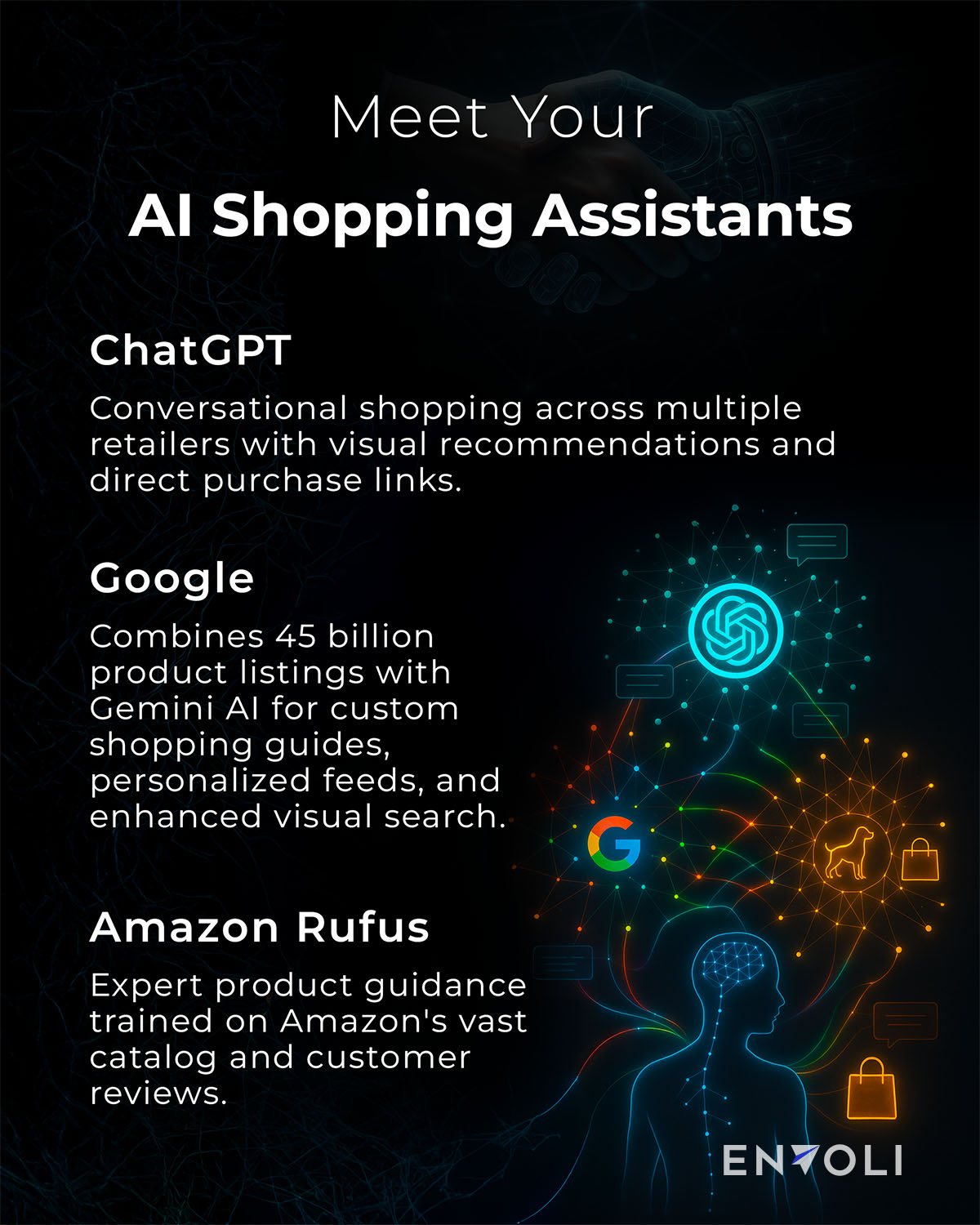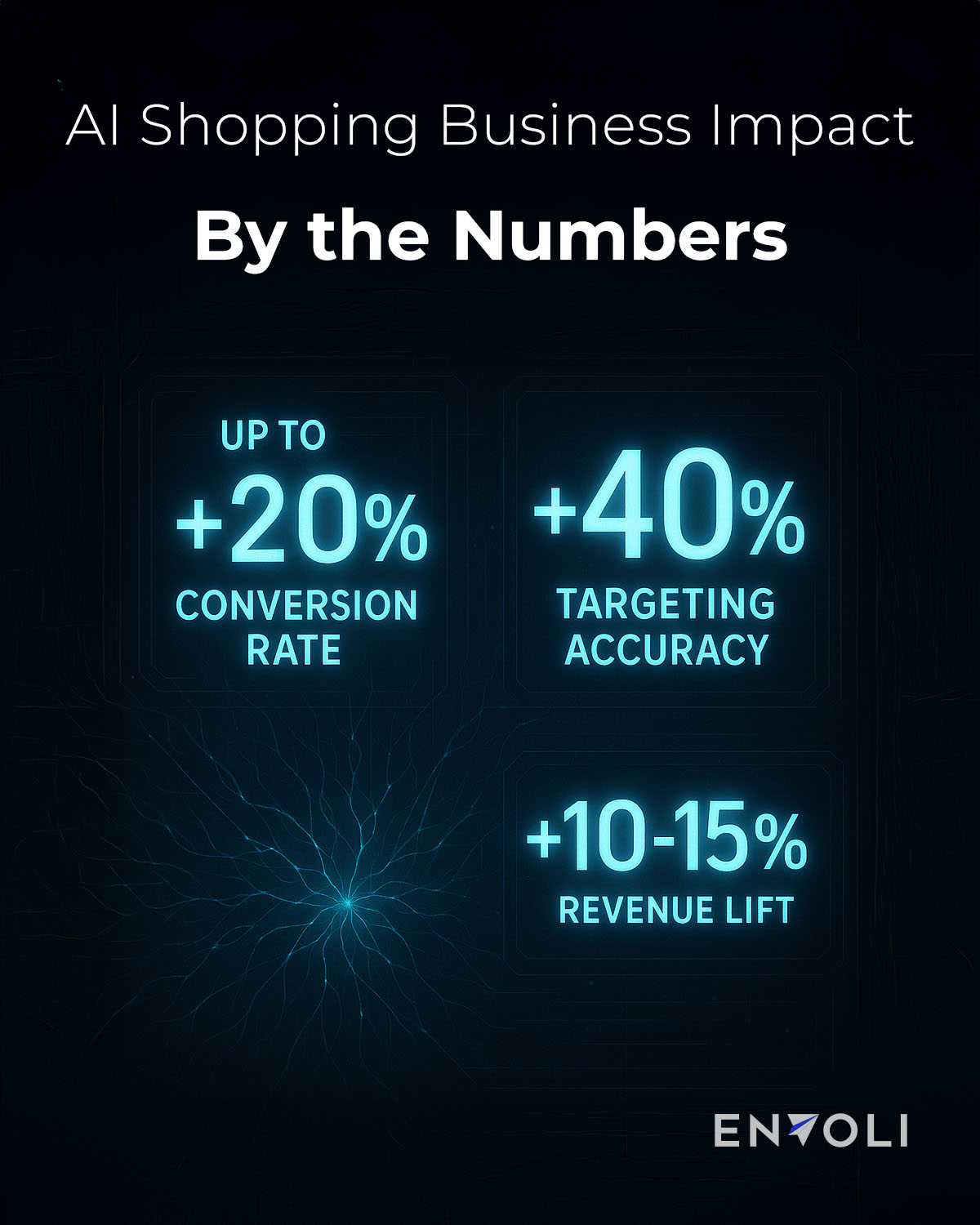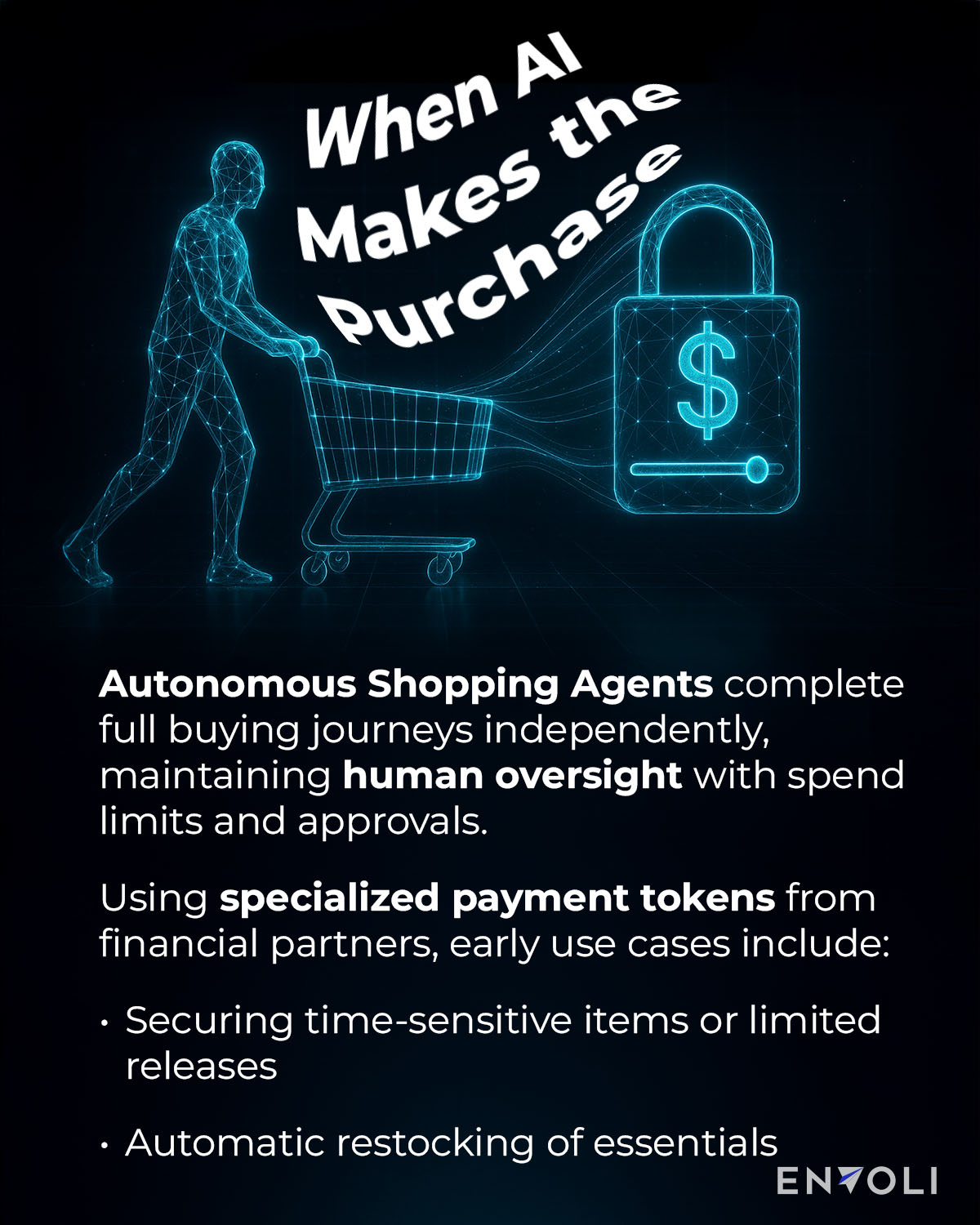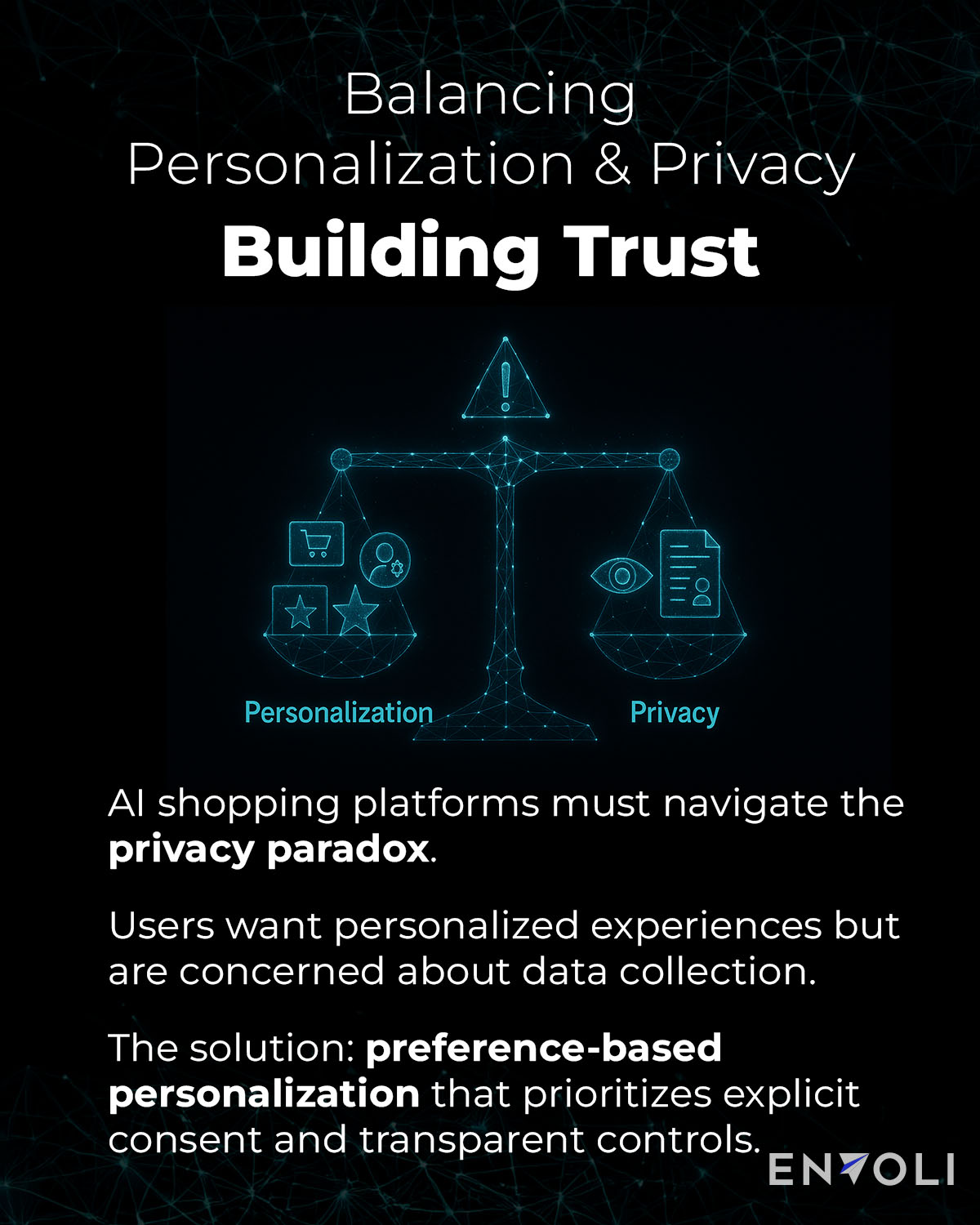The AI Shopping Shift
“I need a sustainable raincoat that will work for both my hiking trip and business travel to London next month, preferably under $200.”
“Can you compare pizza ovens that would fit on my small apartment balcony, prioritizing ones that can reach at least 700°F for authentic Neapolitan crust?”
“Find tennis rackets suitable for my daughter who’s switching from softball. She’s athletic but has never played tennis, is left-handed, and is tall for her age.”
These everyday shopping queries, once directed at in-store sales associates, are now being answered by AI shopping assistants that are transforming how we discover and purchase products online. With ChatGPT processing over 1 billion web searches weekly, shopping has emerged as one of its most sought-after functions.
The scale and speed of this transformation has been remarkable. Tech giants OpenAI, Google, Amazon, and Microsoft have committed unprecedented resources to develop AI shopping capabilities, with investments totaling over $255 billion in 2024 alone ($100B from Amazon, $80B from Microsoft, and $75B from Google).
For consumers, the impact is immediate and tangible. AI-powered shopping has evolved to create conversational experiences that understand context, preferences, and needs.
For retailers and brands, this shift represents both challenge and opportunity. Those embracing AI-powered shopping technologies are seeing remarkable results, with an average 10-15% revenue lift. The competitive advantage is clear and growing.
Our comprehensive analysis examines how AI shopping platforms are reshaping commerce in 2025, exploring the major players, business impacts, and future trajectory of a market that’s projected to reach $8.65 billion this year and more than double to $17.1 billion by 2030.
Major Platforms Transforming Shopping
The AI shopping landscape’s main platforms each have unique capabilities that are reshaping how consumers discover, consider, compare, and purchase products.

AI Shopping With ChatGPT
OpenAI’s ChatGPT has branched out from a general-purpose AI assistant to more specialized roles—including that of a savvy shopping companion. Launched in April 2025, ChatGPT’s shopping features are now available to all users across every tier, including free users and those not logged in—making AI-powered shopping advice accessible to millions worldwide.
The rollout has been swift and widespread, with industry observers quickly spotting the new features in action. An early person to document the change was marketing executive Brett G. Friedman, who shared his discovery on LinkedIn:
In his limited testing with the prompt “I want the best tea in the world,” Friedman discovered that not all product options included a “Buy” button, but those that did linked directly to product detail pages on Shopify. He also noted receiving a “Google Shopping-like sponsored ads carousel with reviews,” commenting that the development was “pretty wild.”
What are ChatGPT’s shopping features?
What sets ChatGPT’s shopping experience apart is its visual, information-rich interface combined with conversational capabilities. When users search for products, they receive:
- Visual product details with high-quality images
- Comparative pricing information from various retailers
- User reviews and ratings aggregated from multiple sources
- Direct purchase links to merchant websites
Unlike traditional shopping platforms, ChatGPT claims to select products based on relevance to the user’s query rather than paid placements. “The recommendations are generated organically, without paid advertisements or commission-based incentives,” states OpenAI. However, it’s worth noting that CEO Sam Altman has indicated openness to “tasteful” advertising models in the future.
The platform is particularly adept at handling complex, multi-faceted shopping queries. For example, rather than simply showing results for “coffee maker,” ChatGPT can process requests like “What’s the difference between drip and pour-over coffee makers?” providing educational content alongside product recommendations.
For Plus and Pro subscribers, ChatGPT has begun integrating its memory features with shopping, allowing the system to remember past preferences and tailor recommendations accordingly.
Amazon’s Rufus Shopping Assistant
While ChatGPT offers a broad shopping experience spanning multiple retailers, Amazon’s Rufus specializes exclusively in helping customers navigate the e-commerce giant’s vast product catalog.
Named after the Welsh Corgi who roamed Amazon’s first warehouse in 1996, Rufus is a conversational AI assistant embedded directly in the Amazon Shopping app. It’s built on a custom large language model trained specifically on Amazon’s entire product catalog, customer reviews, and community Q&A posts, making it uniquely qualified to answer product-specific questions.
Rufus excels at helping consumers in several ways:
- Understanding product details: “Is this air purifier effective for pet allergens?”
- Comparing options: “What’s the difference between synthetic and down insulation for sleeping bags?”
- Contextual recommendations: “Recommend outdoor games for a family reunion with mixed ages”
- Shopping guidance: “What equipment do I need to start birdwatching as a beginner?”
The technical infrastructure behind Rufus is equally impressive. To deliver consistent performance during high-demand events like Prime Day, Amazon deployed over 80,000 AWS Inferentia and AWS Trainium chips across three regions. These purpose-built AI accelerators process an average of 3 million tokens per minute while maintaining response latency under one second, even during peak shopping periods.
Google’s AI-Powered Shopping Overhaul
Google has radically transformed its shopping experience by merging its 45 billion product listings with advanced Gemini AI models. This integration has created what Google calls a “step change” in online shopping—a transformation as significant as the shift from desktop to mobile commerce.
The new Google Shopping experience uses AI in several innovative ways:
- AI-generated shopping guides: When users search for products like “winter cycling gear for cold commutes,” they receive AI-crafted summaries of important considerations (e.g., “Look for windproof front panels and thermal fabrics that balance insulation with breathability”).
- Personalized shopping feed: A scrollable, discovery-oriented interface that continuously learns from user behavior to surface relevant products, videos, and shopping advice.
- Visual search enhancements: Improved capabilities for finding products based on images rather than text descriptions.
- Deal discovery: AI-powered features that help users find the best prices across retailers.
Google’s approach strategically counters two significant threats to its dominance: Amazon‘s growing share of product search and TikTok’s increasing influence among younger shoppers. By incorporating elements of social discovery with its traditional search strengths, Google aims to create shopping experiences that feel more personal and less transactional.
The technology powering Google’s Shopping transformation is its Recommendation AI. Rather than using a single massive AI model that processes all queries regardless of complexity, Google’s approach activates only the specialized components needed for each specific shopping query, making the system both more efficient and more effective at delivering relevant results.
Business Impact: Key Performance Metrics
For companies implementing AI shopping technologies, the financial impact is substantial and measurable across multiple key performance indicators, making AI shopping one of the most compelling investments in retail technology today.

Conversion Rate Improvements
One of the most immediate benefits of AI shopping is significantly higher conversion rates. Some companies implementing sophisticated AI shopping experiences report conversion rate improvements as high as 20% compared to traditional e-commerce interfaces.
This dramatic improvement stems from AI’s ability to deliver more relevant product recommendations, reduce friction in the shopping journey through conversational interfaces, answer pre-purchase questions that might otherwise prevent conversion, and create stronger emotional connections with shoppers through personalized experiences.
These conversion improvements are particularly notable in complex product categories where customers typically require more information before making a purchase decision. Electronics retailers report some of the largest gains, with AI assistants effectively guiding consumers through technical specifications and compatibility concerns.
Revenue Lift and ROI
The implementation of AI shopping technologies typically delivers revenue increases of 10-15%, though the range can vary from 5% to 25% depending on industry sector and how effectively the AI features are implemented. This revenue growth comes not just from higher conversion rates but also from increases in average order value through intelligent cross-selling, customer lifetime value through improved retention, and market share gained from competitors with less sophisticated shopping experiences.
The return on investment for these technologies is compelling. McKinsey research indicates that companies with strong personalization capabilities generate 40% more revenue from these activities than competitors with basic capabilities.
Sephora’s Success
Sephora, a multinational omni-channel retailer for beauty and personal-care goods, implemented AI product recommendations to personalize their customers’ e-commerce experience. Jaclyn Luft, Manager of Site Personalization & Testing at Sephora, said: “Since implementing Recommendations AI we’ve seen impressive results with a 50% increase in CTR on our product pages and a nearly 2% increase in overall conversion rate on our homepage relative to our previous ML-driven recommendations.”
Personalization in Practice
At the heart of AI-powered shopping’s transformative impact is its ability to deliver deeply personalized experiences at scale. Unlike with one-size-fits-all interfaces of the past, dynamically tailored interactions adapt to individual preferences, needs, and contexts.

Short-Term & Long-Term Memory
Traditional e-commerce has relied primarily on session-based personalization that doesn’t carry across multiple interactions. AI shopping platforms are now implementing sophisticated memory systems that enable much richer, context-aware personalization across the entire customer journey.
These memory systems operate at multiple levels:
- Short-term Context: Maintains awareness of the current shopping session, including recent queries, viewed products, and expressed preferences. This allows for coherent conversations where the AI remembers what was just discussed.
- Medium-term History: Learns from patterns in browsing and purchasing behavior over weeks and months to identify seasonal trends, recurring needs, and evolving preferences.
- Long-term Preferences: Builds comprehensive profiles of style preferences, size information, budget parameters, and brand affinities for truly personalized recommendations.
ChatGPT’s integration of memory features with shopping for Plus and Pro users exemplifies this approach. The system can reference previous conversations to provide increasingly personalized recommendations without requiring the user to restate preferences.
For users concerned about privacy, leading platforms provide granular controls over what information is retained. These controls allow users to selectively delete specific memories, temporarily pause memory collection, or even reset the system entirely—balancing the benefits of personalization with individual privacy preferences.
Explicit vs. Implicit Understanding
The most sophisticated AI shopping implementations are now employing two-tiered personalization systems that combine explicit preferences with implicit understanding:
- Explicit Personalization: Based on information users directly provide, such as size preferences, color choices, or budget constraints. Explicit personalization ensures that recommendations respect clearly stated boundaries and preferences.
- Implicit Personalization: Derives insights from observed behavior, such as browsing patterns, time spent examining different products, or response to recommendations. It allows AI shopping assistants to understand not just what users say they want, but what actually resonates with them based on their behavior.
This combination allows AI shopping assistants to understand preferences users may not explicitly articulate or even be consciously aware of. For example, a fashion shopper might state a preference for “professional attire” but consistently engage more with slightly more casual styles. An effective AI shopping assistant can recognize this pattern and adjust recommendations accordingly, potentially surfacing “business casual” options that better match the user’s true preferences.
This capability creates an interesting dynamic where AI sometimes appears to understand customers’ preferences better than they understand themselves. While this can lead to delightfully accurate recommendations, it also creates mixed feelings for some users who find the implied behavioral insights unsettling.
Proactive Discovery
Perhaps the most significant advancement in AI-powered shopping is the shift from reactive search to proactive discovery. Traditional e-commerce requires users to initiate the shopping process by actively searching for products. AI shopping platforms are increasingly able to anticipate needs and interests, surfacing relevant products before users actively search for them.
Amazon’s Interests feature represents one of the most sophisticated implementations of this approach. The system allows users to describe their ongoing interests in natural language, such as “High-performance running gear for marathon training” or “Mid-century modern furniture for a small apartment.” The system translates these natural language descriptions into structured queries that continuously monitor inventory for matching products.
What makes this approach particularly powerful is its ability to identify products that might not appear in traditional keyword searches. If a customer expresses interest in “handcrafted toys made from natural materials for toddlers,” the system can identify products that match this description even if they don’t explicitly use those exact terms in their listing.
Autonomous Shopping: When AI Makes the Purchase
The evolution of AI-powered shopping has reached a new frontier with autonomous shopping agents—AI systems that can independently complete transactions on behalf of consumers.

Secure Payment Systems
For AI agents to make purchases autonomously, a secure and reliable payment infrastructure is essential. Major financial companies have developed specialized solutions to address this need.
Visa’s Intelligent Commerce platform represents one of the most comprehensive approaches to enabling AI-driven purchases. Launched in April 2025 in collaboration with AI leaders including Microsoft, IBM, OpenAI, Anthropic, and Stripe, the platform creates a secure way for AI agents to execute transactions on behalf of consumers.
The system uses what Visa calls “AI-Ready Cards,” which replace traditional card details with tokenized digital credentials specifically designed for AI-mediated transactions. This approach allows consumers to delegate transaction authority to AI agents without exposing sensitive payment information.
Mastercard’s parallel solution, Agent Pay, offers “Agentic Tokens” for secure delegation of payment authority. These tokens enable AI systems to complete purchases while maintaining robust security protocols.
Mastercard’s approach focuses on creating a standardized way for merchants to accept payments from AI agents without requiring extensive modifications to existing payment infrastructure. This creates a seamless experience where consumers can delegate shopping tasks without needing to understand the technical details of how payments are secured.
Consumer Safeguards
Both consumers and financial institutions have legitimate concerns about autonomous shopping systems. To address these concerns, current implementations emphasize user control through several key mechanisms:
- Spending Controls: Users can set maximum transaction amounts, both per purchase and over time periods like days or months. For example, a consumer might allow their AI shopping agent to make grocery purchases up to $50 individually, with a monthly cap of $300.
- Category Restrictions: For more precise control, shoppers can limit AI agents to specific product categories or approved merchants. This allows delegation of routine purchases while preventing unexpected spending in other areas.
- Approval Workflows: For higher-value or unusual transactions, systems can require human confirmation before completion. This creates a hybrid approach where the AI handles research and selection while the human retains final authority on significant purchases.
- Transparent Reporting: Detailed logs of all AI-initiated transactions provide accountability and visibility, allowing consumers to review autonomous purchasing activity and adjust permissions if needed.
By giving users confidence that their AI agents will operate within well-defined boundaries, these safeguards lower psychological barriers, building trust while protecting both consumers and financial institutions from potential misuse.
The parallels to early e-commerce are striking. Just as consumers once had to overcome fears about entering credit card information online, today’s shoppers must develop trust in delegating purchasing authority to AI systems. The difference is that today’s trust infrastructure is being built proactively rather than reactively, with major financial institutions leading the development of security protocols specifically designed for AI commerce.
Real-World Applications
While fully autonomous shopping remains in its early stages, several compelling use cases are already emerging:
Household Staples Replenishment
The most widely adopted application involves automating the purchase of regularly consumed household items. Rather than manually reordering essentials like laundry detergent, pet food, or coffee beans, consumers can delegate these purchases to AI agents that monitor usage patterns and proactively place orders before supplies run out.
This use case builds on earlier subscription services but adds intelligence. The AI can adjust order timing based on analysis of purchasing history and user behavior rather than fixed intervals, switch to better-value alternatives when appropriate, and pause deliveries when a household is traveling.
Time-Sensitive Purchasing
Another promising application involves delegating time-sensitive purchasing decisions to AI agents. Concert tickets, limited-edition product drops, or flash sales all represent scenarios where automated purchasing provides significant advantages.
Complex Shopping Tasks
The most advanced implementations combine autonomous shopping with broader planning capabilities. For instance, an AI agent might be tasked with “planning a camping trip for four people” and autonomously purchase appropriate gear, food supplies, and other necessities within a specified budget.
Navigating Challenges
Despite the tremendous promise of AI-powered shopping, significant challenges must be addressed for these systems to reach their full potential while ensuring user trust and sustainable value for all stakeholders.
Balancing Monetization and User Experience

A fundamental tension exists between the business imperatives of AI shopping platforms and the ideal user experience. As these platforms seek revenue models to support their significant infrastructure investments, they face difficult choices about how to monetize without degrading the user experience.
Currently, most major AI shopping platforms—including ChatGPT, Google, and Amazon’s Rufus—emphasize that their product recommendations are not influenced by paid advertising. However, monetization pressures will inevitably increase as these platforms mature.
Several potential monetization approaches are emerging, including transaction fees, premium subscription tiers, value-added services for merchants, and transparently labeled sponsored content. But will whatever model they land on be aligned with user interests?
Some critics skeptical of OpenAI’s new shopping features have invoked author Cory Doctorow’s concept of “enshittification“—the gradual deterioration of platforms as they shift from serving users to extracting maximum value from them. As Doctorow explains it: “Surpluses are first directed to users; then, once they’re locked in, surpluses go to suppliers; then once they’re locked in, the surplus is handed to shareholders and the platform becomes a useless pile of shit.”
Regarding OpenAI’s claim that ChatGPT’s AI shopping recommendations aren’t paid advertisements, one Reddit user commented: “I give it less than six months before that changes.”
Avoiding the enshittification trajectory will require deliberate choices by platform providers to create sustainable business models that maintain balance between user benefits and business incentives.
Building Trust Through Privacy
The level of personalization that makes AI shopping so compelling inevitably raises significant privacy concerns. These systems require extensive data about user preferences, behavior, and context to deliver tailored experiences that feel truly personal.

Consumers today face what researchers call the “privacy paradox”—they simultaneously desire highly personalized experiences while expressing concerns about the data collection necessary to enable those experiences. In fact, McKinsey research found that 71% of consumers expect companies to deliver personalized interactions, yet many of those same consumers are uncomfortable with how their data is collected and used.
Leading platforms are addressing these concerns through preference-based personalization models. Rather than tracking users across the web to build behavioral profiles, these systems focus on understanding explicitly stated preferences and shopping contexts. This approach addresses privacy concerns, and also turns out to be good business. In fact, Preference-based personalization often yields more accurate and useful recommendations. A recent study found up to a nearly 10% reduction in errors compared to state-of-the-art, albeit non-AI-powered, models.
Privacy researchers are increasingly advocating for structural changes to how data collection works online. In a Stanford University white paper, Jennifer King and Caroline Meinhardt advocate for opt-in data sharing models. “I would argue that the default should be that our data is not collected unless we affirmatively ask for it to be collected,” states King. The researchers point to Apple’s App Tracking Transparency as an example, where 80-90% of users choose not to be tracked when explicitly asked. Clearly, most consumers would prefer greater privacy if given an honest choice. Recognizing this preference, policymakers could resolve the privacy paradox by mandating default settings that actually align with what consumers want.
The Future Shopping Landscape
AI shopping promises an unprecedented transformation in how we discover and purchase products—arguably the most significant shift since e-commerce itself emerged.

Blurred Boundaries Between Discovery and Purchase
Rather than treating shopping as a separate activity, AI is enabling seamless integration of commerce into everyday digital experiences. As such, the boundaries between information, entertainment, and transaction are increasingly blurred.
Search engines like Google are erasing the boundary between informational queries and shopping activities. Meanwhile, content across video, gaming, and other media is becoming shoppable through AI technologies that can identify products and initiate purchases without disrupting the entertainment experience.
The End of Traditional Search
Instead of searches based on keywords, shoppers can express needs in everyday language, receiving direct answers and specific recommendations that address the underlying intent of their queries.
Further, the proactive capabilities of AI systems anticipate needs and surface relevant products before users even actively search for them, fundamentally changing the relationship between consumers and retailers.
Balanced, Human-Centered Innovation
Realizing the full potential of AI shopping requires thoughtfully addressing the challenges it presents. Transparency in how AI systems operate, user control over personal data, ethical monetization that aligns business interests with user benefits, and inclusive design that makes AI shopping accessible to diverse users will be critical for creating sustainable, user-centered experiences.
The companies that successfully navigate these challenges will shape not just the future of shopping but our broader relationship with AI in daily life. The most powerful AI shopping implementations won’t eliminate human judgment but will redistribute it. By automating routine decisions and research, they’ll free consumers to focus on the more meaningful aspects of consumption. These are the emotional connections to products, the ethical considerations of purchases, and the experiential dimensions that algorithms struggle to quantify. The human remains the ultimate authority, but with superpowers that dramatically expand their shopping capabilities.
The integration of AI into shopping may fundamentally redefine our relationship with consumption itself. The next five years will likely see a polarization between hyper-convenience and hyper-curation, with AI simultaneously making routine purchases nearly invisible while enabling deeper discovery and connection for products where care for the details really matter.
The winners in this new landscape will be those that best balance automation with authenticity, creating experiences that feel effortless, and when appropriate—deeply personal.
Let's Talk Strategy.
Ready to launch a product, accelerate growth, or test a new idea for market demand? Let's talk.


